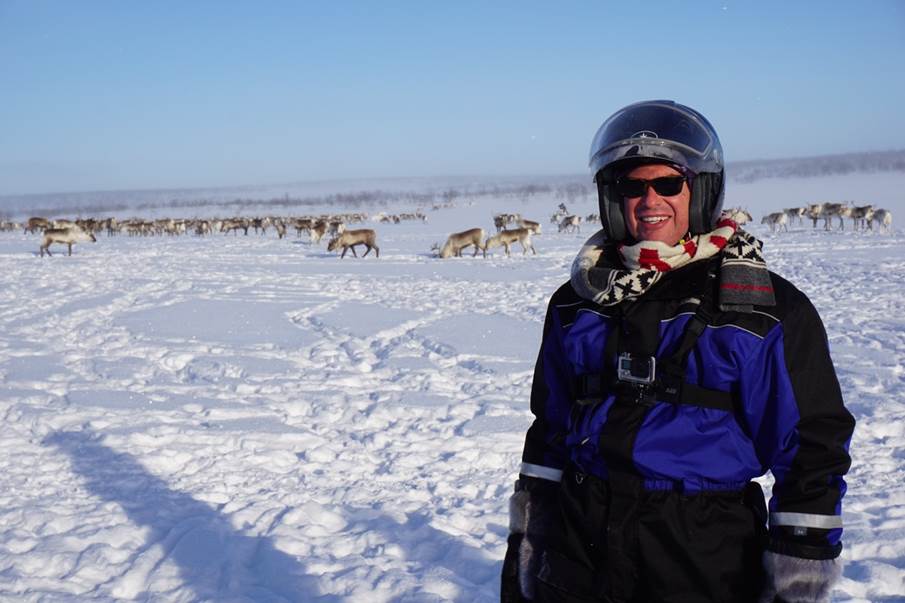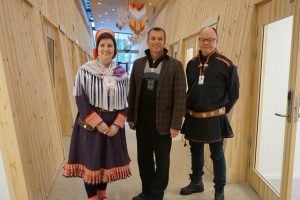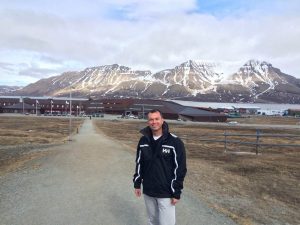Arctic Diplomacy – Daily engagement in support of our Shared North

Artur Wilczynski reindeer herding in Finnmark with members of the Sami community. Photo: Bjorn Hernes
When thinking of Arctic diplomacy, one is drawn to the significant work of the Arctic Council. One may also think of the United Nations system and the important work being done under the UN Convention on the Law of the Sea to settle claims related to the continental shelf. What is often forgotten in the mix of Arctic politics and diplomacy is the central role of bilateral relations in advancing cooperation and understanding between nations and people in the High North. In my view, Arctic diplomacy is about connections and people.
As an Ambassador, I speak with key governmental agencies such as the Ministry of Foreign Affairs, or the Ministry of Trade, Industry and Fisheries. Governmental engagement is key to any diplomatic role. However, I have found the people-to-people connections to be most rewarding and effective in building bridges between our countries. Engaging with Indigenous peoples, with youth and academic institutions has been an important part of Canadian diplomacy in Norway’s North.
As Canada’s Ambassador to Norway, I am an Arctic Ambassador. It has been one of the most rewarding aspects of the job. It surprises me how much of my day-to-day work is related to Arctic issues and activities. My job has been to focus on more personal interactions; to meet people all over Norway and talk about Canadian experiences and perspectives. It may not be high diplomacy, but it builds connections between our countries.
Before appointed Ambassador, I had been to the Arctic once – in 1997. I travelled to Iqaluit, Nunavut for a conference. Being there in August, I was struck by the landscape – the beautiful colors of the tundra – the caribou out in the distance. My experience 20 years ago was but a taste – a foreshadowing of how important this region has become to me today.
I often use a large map of Canada when I talk about the North, to illustrate its vast distances and particular challenges. I tell Norwegians that the population of Canada’s Arctic is about the same as the cities of Tromsø and Bodø. I superimpose a map of Norway drawn to scale and at latitude on top of the map of Canada. Most Norwegians laugh when they see their country is smaller than Baffin Island (Norway is 385,000 km2, while Baffin Island is 507,000 km2). The population of Norway’s Arctic is almost half a million people, almost 4 times greater than Canada’s, and they fit into a tiny sliver of land. Indigenous peoples are the majority in Nunavut and the Northwest Territories, while the Sami people are a central part of Northern Norway. However, the estimated Sami population in Norway is only 50,000. Even if they all lived in Arctic Norway (they don’t), they would amount to just 10% of the population. Thus, the context for the discussion of Arctic politics is completely different in Norway and Canada. This is a starting point for an important dialogue about the Arctic – its peoples and our shared stewardship of this fragile part of the globe.
Engaging with Indigenous Peoples
Over my time in Norway, I have had the opportunity to work closely with Sami leaders. Last winter, I travelled to Kautokeino in Finnmark, Northern Norway, which is one of the hubs for the Sami people. I met Municipal leaders and representatives of the Sami University College to discuss a wide range of local issues. The visit was a chance to meet the organizers of the International Sami Film Institute and learn about their cooperation with Nunavut Film Development Corporation for Arctic Circle Project. Here, I learned about the challenges of producing and distributing films made in and about the North. There is an increasing interest in the role of culture and creative industries in the Arctic. I have been asked to be a moderator during the upcoming Arctic Arts Summit in Harstad in June 2017. The purpose of the summit is to strengthen and promote circumpolar arts and culture. The people of the North – in particular the Indigenous peoples of the Arctic – are the foundation for its development.
Visiting Finnmark allowed me to get to know the reindeer herding traditions of the Sami people. I was invited by Sami leaders to spend a night at a cabin and go out on the plateau with them as they guided their herds. Spending time with the Sami people allowed me to listen to what they had to say – to understand the issues from their perspective. Our discussions covered a wide range of questions – from Norway’s relationship with Russia to climate change and the Sami’s relationship with the Norwegian Ministries of Agriculture and Environment. It was also a chance to appreciate how Sami traditional knowledge is important to managing herds, as well as understanding the impacts of climate change on Sami practices. This insight is very valuable as a diplomat who is trying to understand the complexity of Arctic Norway.
Spending time with the Sami allowed me to hear about their own experiences with forced assimilation, loss of culture and identity. These discussions enabled me to speak about Canada’s history and the damage we caused to First Nations, Metis and Inuit in Canada through residential schools. It enabled me to speak about Canada’s Truth and Reconciliation Commission – the process where over a period of years, victims of the residential school system in Canada were able to speak about how these institutions subjected them to physical, mental and spiritual violence. This process allowed individuals and communities to speak openly about the multigenerational effects of the system on Indigenous peoples across the country. The Commission allowed all Canadians to talk about the long journey we have embarked on to reconcile with this troubled past. This experience is of great interest to Sami people who also experienced forced assimilation policies in the past.

These are ongoing conversations – not only in places like Karasjok and the Sami Parliament, but throughout all of Norway. In Trondheim at the ISFIT (International Student Festival in Trondheim) Conference, I moderated a panel on human rights where we addressed issues related to remembrance and reconciliation. At the University of Oslo’s Norwegian Centre for Human Rights, I was able to engage young law students about Canada’s evolving relationship with Indigenous peoples in a manner that made them reflect on the nature of the relationship between Norway and the Sami people. It is this human aspect of diplomacy that I believe enables us to have an honest dialogue about our countries and how we can work together for the benefit of all our citizens.
Engaging Youth
One of the best opportunities I have had to engage Norwegians and others in a discussion of the North has been as a mentor for the Emerging Leaders of the Arctic Frontiers program. Participating in this program, which takes place in Norway’s High North, together with 30 young people from around the world has been an incredible privilege. This program allowed me to share my expertise and knowledge of diplomacy and communications together with a passionate group of Arctic scientists and experts. It was a valuable chance for me to listen and to learn about the complexity, vitality and importance of the Arctic. This yearly program provided me with access to information, experts and insight about the Arctic that was exceptional. It allowed me to better understand Canada and Norway’s Arctic, what our shared interests may be, and what opportunities may arise in the future in the context of Canada-Norway bilateral relations.
Being a mentor for the past three years has given me the opportunity to learn much from those youth participating in the program. It has enabled me to meet some great young Indigenous leaders from Canada. These young people have taught me a great deal about listening to the specific experiences of Indigenous peoples around the world and they motivated me to engage more with the Indigenous people of Norway.
Additionally, working with programs such as Young Ambassadors in Oslo has enabled me to share information about Canada’s Arctic. Having Norwegian youth express an interest in Canada’s North and gaining a better understanding of Indigenous people in Canada has been important. This program brings together high performing secondary school students and provides them with a broad range of experiences to pique their interest in global issues. Working with them, presenting about Canada’s history – presenting about the people and physical environment in Canada’s North – creates a bond and an interest that will last a long time. This is key in building long term sustainable partnerships between Canadians and Norwegians.
Academic Institutions
Engaging with young people directly or through better partnerships with academic institutions is part of the Embassy’s strategy in promoting closer relations and a better understanding of Canada in Norway. Key partners in promoting this relationship have been UiT: Arctic University of Norway, the Norwegian University of Science and Technology (NTNU), University of Bergen, Nord University and University of Oslo. All these institutions have been key in building awareness and engagement on Arctic issues with Canada.
For example, the University of Oslo has organized two different sessions with their law school. As already mentioned, one session with the Norwegian Centre for Human Rights focused on the renewal of Canada’s relationship with Indigenous peoples. This presentation enabled the Embassy to reach a significant number of Masters level law students on key Indigenous issues associated with Canada’s Arctic region. The University is also reaching out to French speaking students and creating similar opportunities to discuss the specific challenges of the Arctic.
Another key academic relationship is between the UiT and the University of Saskatchewan’s International Centre for Northern Governance and Development. The joint Master degree program in Governance and Entrepreneurship has been essential in creating space where northern and Arctic experiences in Canada and Norway can be shared and better understood. It has been a great pleasure to work with so many wonderful University of Saskatchewan students, and faculty here in Norway have formed an irreplaceable bridge between our two countries.
The relationship between the UiT and Memorial University in St. John’s, Newfoundland has also been particularly productive. These two key national institutions have created a specific venue – the Arctic Forum – where Indigenous peoples, municipal leaders, researchers, businesses and academics can all exchange views about how Canada and Norway can partner on specific issues related to improving the lives of our citizens. Whether examining the effects of adventure tourism on small northern communities, or looking at oil spill response and emergency management, the topics that this forum examines are tangible and practical. Relationships between academic institutions happen naturally – it is part of their own mandates. As a Canadian embassy we work together with academic institutions to identify and promote opportunities to increase academic mobility. By building these links, we gain better insight into the complexities of key issues and have access to key opinion shapers and leaders on questions that are of interest to both countries.
Conclusion
At the end of the day, Arctic diplomacy is about connections and people. As an Ambassador it is my role to find the people with the interest and the ability to deepen the ties between Canada and Norway. It is our Embassy’s role to help create an appetite for those connections to be made and it is our challenge to help sustain them. Arctic diplomacy is about experts’ meetings and senior official gatherings. It is about creating conventions and agreements that guide the overall nature of our engagement on the Arctic. But meetings with students and community groups and universities do the same thing. Building connections between individuals, companies, institutions and governments is a long term project. It requires attention and effort, and in my view, this is the core of Arctic diplomacy.
Artur Wilczynski is the former Canadian Ambassador to Norway. (Update on 25 August 2018).
